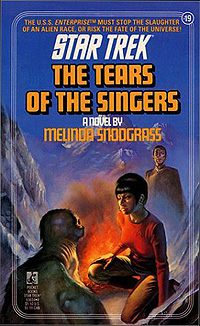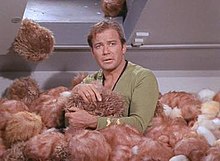
Star Trek: The Animated Series (TAS) is an American animated science fiction television series created by Gene Roddenberry. It originally aired simply under the title Star Trek, subtitled Created by Gene Roddenberry, on Saturday mornings from September 8, 1973 to October 12, 1974 on NBC, spanning 22 episodes over two seasons. The second series in the Star Trek franchise, it features mostly the same characters as Star Trek: The Original Series. Set in the 23rd century, the series follows the further adventures of the Starship USS Enterprise as it explores the galaxy.

The Romulans are an extraterrestrial race in the American science fiction franchise Star Trek. Their adopted home world is Romulus, and within the same star system they have settled a sister planet Remus. Their original home world, Vulcan, was renamed Ni'Var later in canon. They first appeared in the series Star Trek (1966–1969). They have appeared in most subsequent Star Trek releases, including The Animated Series, The Next Generation, Deep Space Nine, Voyager, Enterprise, Discovery, Picard, Strange New Worlds, and Lower Decks. They appear in the Star Trek feature films Star Trek V: The Final Frontier (1989), Star Trek VI: The Undiscovered Country (1991), Star Trek: Nemesis (2002) and Star Trek (2009). They also appear in various other spin-off media, including books, comics, toys and games.

Trekkies is a 1997 documentary film directed by Roger Nygard about the devoted fans of Gene Roddenberry's Star Trek. It is the first film released by Paramount Vantage, then known as Paramount Classics, and is presented by Denise Crosby, best known for her portrayal of Security Chief Tasha Yar on the first season of Star Trek: The Next Generation.

The Rolling Stones is a 1952 science fiction novel by American writer Robert A. Heinlein.

David Gerrold is an American science fiction screenwriter and novelist. He wrote the script for the original Star Trek episode "The Trouble with Tribbles", created the Sleestak race on the TV series Land of the Lost, and wrote the novelette "The Martian Child", which won both Hugo and Nebula Awards, and was adapted into a 2007 film starring John Cusack.

"The Trouble with Tribbles" is the fifteenth episode of the second season of the American science fiction television series Star Trek. Written by David Gerrold and directed by Joseph Pevney, it was first broadcast on December 29, 1967. In this comic episode, the starship Enterprise visits a space station that soon becomes overwhelmed by rapidly reproducing small furry creatures called "tribbles."
"Encounter at Farpoint" is the pilot episode and series premiere of the American science fiction television series Star Trek: The Next Generation, which premiered in syndication on September 28, 1987. It was written by D. C. Fontana and Gene Roddenberry and directed by Corey Allen. Roddenberry was the creator of Star Trek, and Fontana was a writer on the original series. It was originally aired as a two-hour TV movie, and subsequent reruns typically split the episode into two parts.

"Pigs Is Pigs" is a story by American writer Ellis Parker Butler. First published as a short story in American Illustrated Magazine in September 1905, "Pigs Is Pigs" went on to dozens of printings as a book and in anthologies over the next several decades.
"More Tribbles, More Troubles" is the fifth episode of the first season of the animated American science fiction television series Star Trek. It first aired in the NBC Saturday morning lineup on October 6, 1973, and was written by David Gerrold as a sequel to his Original Series episode "The Trouble with Tribbles". It features actor Stanley Adams reprising his role of trader Cyrano Jones, and the return of the fuzzy, rapidly reproducing creatures called tribbles.
"I, Mudd" is the eighth episode of the second season of the American science fiction television series Star Trek. Written by Stephen Kandel and directed by Marc Daniels, it was first broadcast on November 3, 1967.
"A Private Little War" is the nineteenth episode of the second season of the American science fiction television series Star Trek. Written by Gene Roddenberry, based on a story by Don Ingalls, and directed by Marc Daniels, it was first broadcast on February 2, 1968.
"The Mark of Gideon" is the sixteenth episode of the third season of the American science fiction television series Star Trek. Written by George F. Slavin and Stanley Adams and directed by Jud Taylor, it was first broadcast on January 17, 1969.
"The Emissary" is the twentieth episode of the second season of the American science fiction television series Star Trek: The Next Generation, the 46th episode overall, first airing on June 26, 1989.
"Affliction" is the fifteenth episode of the fourth season of the American science fiction television series Star Trek: Enterprise, and originally aired on February 18, 2005. The script was written by Mike Sussman from a story by executive producer Manny Coto. It was the second episode of Enterprise to be directed by Michael Grossman. The episode is the first of a two-part story, which concludes with "Divergence".

"The Expanse" is the fifty-second episode of Star Trek: Enterprise, the twenty-sixth episode and finale of Season Two. The episode launched a change of direction for the series, starting with a cataclysmic attack on the Star Trek version of Earth and introducing a new alien foe, the Xindi.
"Reunion" is the 81st episode of the syndicated American science fiction television series Star Trek: The Next Generation. It is the seventh episode of the fourth season.

"Trials and Tribble-ations" is the 104th episode of the American science fiction television series Star Trek: Deep Space Nine, the sixth episode of the fifth season. It was written as a tribute to the original series of Star Trek, in the year of that show's 30th anniversary; sister series Voyager also produced a tribute episode, "Flashback".
"Bem" is the second episode of the second season of the American animated science fiction television series Star Trek, the 18th episode overall. It first aired in the NBC Saturday morning lineup on 14 September 1974, and was written by David Gerrold, who wrote the earlier episode "More Tribbles, More Troubles" and worked on several Original Series episodes. This episode marks the first time that Captain James T. Kirk's full name is given, revealing that the middle initial stood for Tiberius, after the Roman emperor.

Trek to Madworld (1979) is a science fiction novel by American writer Stephen Goldin, first published by Bantam Books in January 1979. One of the original Star Trek novels set in the universe of the original Star Trek television series, it had an introduction by David Gerrold.

The Tears of the Singers is a science fiction novel by American writer Melinda M. Snodgrass, part of the Star Trek: The Original Series franchise. It was her first and only Star Trek novel, which led to Snodgrass writing for Star Trek: The Next Generation. Writer Victor Milán was also involved in the initial discussion of the plot for the novel.














